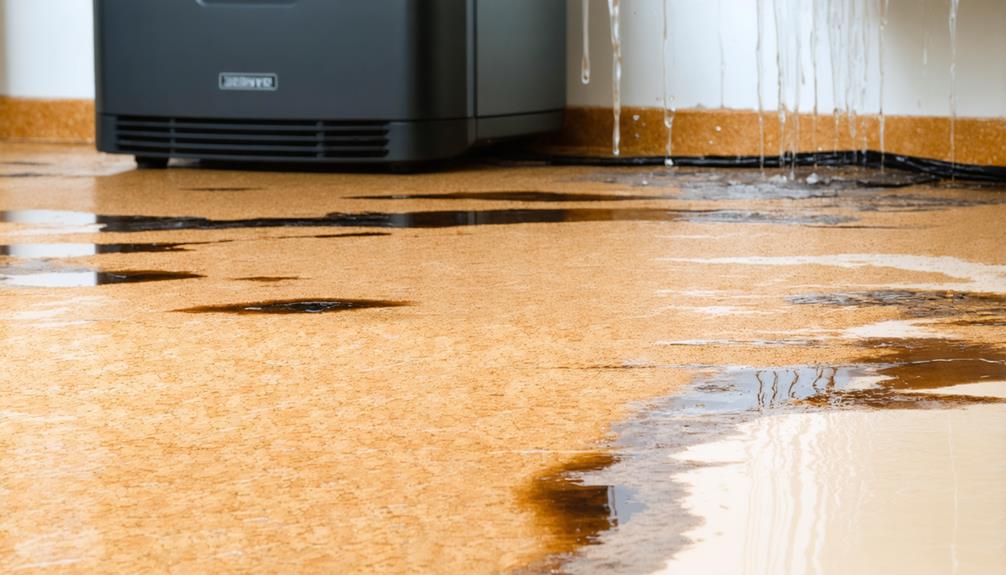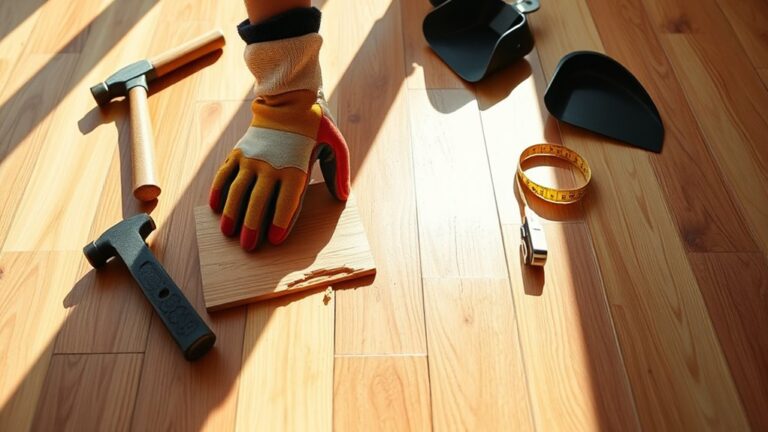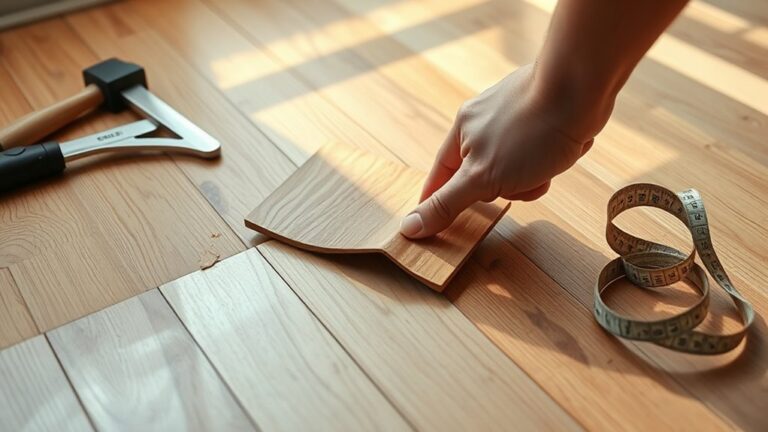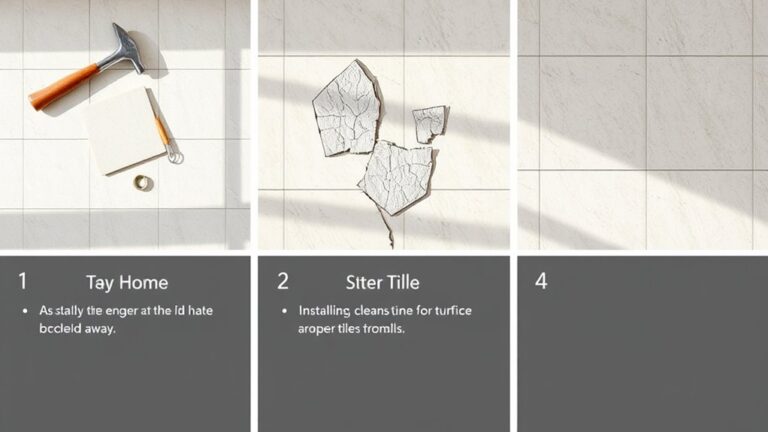Cork floors in humid areas are vulnerable to several issues that you should be aware of. The material's porous nature makes it prone to moisture absorption, which can lead to warping and mold growth. High humidity can also cause expansion, leaving gaps or misalignment between planks. Additionally, heavy objects can create indentations and scratches without proper protective measures. Regular maintenance, including sealing and monitoring humidity levels, is essential to mitigate these problems. Proper installation techniques, like maintaining expansion gaps, are vital for long-term performance. You'll find valuable tips to help protect your cork flooring from these challenges.
Susceptibility to Damage
Cork flooring often faces significant susceptibility to damage, particularly in environments with heavy foot traffic or where large furniture is present. Its inherent softness, while providing comfort underfoot, makes it prone to indentations from heavy items and high heels. If you don't use protective pads beneath furniture, you'll likely notice unsightly marks and scratches developing over time.
Moreover, frequent movement of heavy objects can mar the cork surface, leading to both scratches and wear that diminish its aesthetic appeal. In high-traffic areas, the flooring can wear down rapidly, reducing its lifespan compared to traditional hardwoods. In humid environments, the situation worsens. Cork's natural properties allow it to expand and contract with fluctuations in moisture levels. This constant movement not only leads to warping but can also exacerbate existing damage, further compromising the floor's integrity.
When humidity levels rise, you might find the flooring buckling or forming gaps, making it essential to maintain a stable indoor climate. Using dehumidifiers or air conditioning can help mitigate these effects, but it's vital to be proactive. Ultimately, while cork flooring offers unique benefits, its susceptibility to damage necessitates careful consideration of its placement and maintenance, particularly in humid areas. You'll want to weigh these factors before fully committing to cork as your flooring choice, especially if your lifestyle involves heavy furniture or frequent gatherings.
Sensitivity to Humidity
Cork flooring's sensitivity to humidity can lead to significant expansion and contraction, which may cause warping or cupping over time. Its porous nature makes it vulnerable to moisture absorption, increasing the risk of swelling and mold in humid conditions. To mitigate these issues, proper installation practices, including acclimation and maintaining a consistent humidity level, are essential for preserving the integrity of your cork floors.
Expansion and Contraction Effects
During periods of fluctuating humidity, the expansion and contraction effects of cork flooring become particularly pronounced. Cork's sensitivity to humidity means it can expand considerably, sometimes up to one inch, if moisture levels rise. This movement necessitates adequate expansion gaps of at least 1/2 inch around walls and doorways to accommodate the natural shifting, preventing potential damage.
Consider these key points to manage cork flooring in humid areas:
- Monitor humidity levels: Aim for a relative humidity between 30-50% to minimize expansion.
- Choose the right installation method: Floating floors allow for more movement compared to glue-down options, which can warp.
- Inspect regularly: Look for gaps or buckling, especially within months of installation.
- Plan for seasonal changes: Anticipate fluctuations in humidity as seasons change to proactively address potential issues.
Ignoring cork's expansion in high humidity can lead to visible separation and gaps, compromising the flooring's integrity. Keeping these factors in mind will help you maintain the beauty and functionality of your cork floors while handling the challenges posed by humidity.
Moisture Absorption Risks
Moisture absorption poses essential risks to the longevity and performance of cork flooring. Due to its highly porous nature, cork can readily absorb moisture in humid environments, leading to issues such as swelling, warping, and even mold growth. If you're living in a region with high humidity levels, you must be aware of how this can affect your flooring choice. Without regular sealing, your cork flooring is left vulnerable and can deteriorate rapidly when exposed to damp conditions.
Moreover, fluctuations in humidity can cause cork to expand and contract, leading to gaps and misalignment between planks. This movement is especially problematic if your cork is glued down, as it doesn't accommodate moisture-related shifts as effectively as floating installations do. To mitigate these risks, it's important to maintain a relative humidity level of 30-50% in your home. By doing so, you can greatly reduce the chances of excessive moisture absorption and its associated issues, ensuring that your cork flooring remains both functional and aesthetically pleasing over time.
Installation Best Practices
When selecting cork flooring, understanding installation best practices is key to guaranteeing its longevity, especially in areas with fluctuating humidity. Proper acclimation of glue-down cork is vital; this allows the flooring to adjust to local humidity levels before installation, preventing contraction and seam formation later on. For floating floors, leave a minimum of ¼ inch space around the perimeter for expansion, and consider increasing this space to ½ inch in high humidity areas to avoid buckling.
Here are some essential installation tips:
- Always include expansion joints every 30 feet in larger areas to accommodate natural expansion.
- Confirm the subfloor is level and dry; uneven surfaces can worsen humidity-related issues.
- Regularly check humidity levels, aiming for 30-50% to maintain flooring integrity.
- Use appropriate underlayment to enhance sound absorption and moisture control.
Taking these best practices into account will help your cork flooring withstand the challenges of humidity, allowing it to expand and contract appropriately, and consequently extending its lifespan and maintaining its appearance.
Fading Potential
Fading potential is a significant concern for homeowners considering cork flooring, as prolonged exposure to direct sunlight can lead to noticeable discoloration over time. This issue is exacerbated in humid environments, where the combination of moisture and UV rays can accelerate fading. In high-traffic areas, where sunlight exposure is consistent, the fading potential becomes even more pronounced, resulting in uneven coloration that detracts from the flooring's aesthetic appeal.
To combat this, you should consider implementing protective measures. Using window treatments, such as blinds or curtains, can effectively shield your cork flooring from harmful rays. Additionally, UV-protective coatings are available that can be applied to the surface to minimize fading. These steps are vital, especially in rooms with large windows or south-facing exposures.
It's important to note that cork's limited range of styles and finishes can make the fading more noticeable compared to other flooring materials. Regular maintenance is essential; routine cleaning and applying appropriate sealants can help preserve the original color and vibrancy.
Higher Costs
While the aesthetic concerns of cork flooring, such as fading, are important, the financial implications also warrant careful evaluation. Cork flooring typically carries a higher initial cost compared to conventional options. This is often due to its eco-friendly production and sustainable harvesting practices. However, you should also factor in installation expenses, particularly if a complex glue-down method is necessary, as this can considerably escalate your overall costs.
Moreover, long-term maintenance costs can be higher than you might anticipate. Regular sealing and periodic refinishing are essential to maintain both durability and appearance, especially in areas with higher humidity. These ongoing expenses can add up over time, impacting your budget.
Here are some essential financial aspects to take into account:
- Initial investment: Higher upfront costs due to eco-friendly materials.
- Installation fees: Additional expenses if complex installation methods are required.
- Maintenance costs: Ongoing sealing and refinishing necessary for durability.
- Resale value: Potentially lower resale value compared to traditional hardwoods.
Ultimately, the total cost of ownership for cork flooring can be influenced by the need for protective measures against moisture and humidity. These precautions might require further investment, so it's crucial to analyze your budget thoroughly before making a decision. Understanding these financial implications will empower you to choose the best flooring option for your needs.
Installation Challenges
When installing cork flooring, you need to pay close attention to proper techniques, especially regarding acclimation and expansion gaps. For humid areas, leaving at least a ½ inch gap around walls is vital to allow for natural expansion. Additionally, ensuring the short edges of planks are engaged can prevent common issues like lipping and gapping, making precision in your installation essential.
Proper Installation Techniques
In humid environments, proper installation techniques are vital for guaranteeing the longevity and performance of cork flooring. Using floating floor installations is fundamental, as it allows for natural expansion and contraction of the material without causing damage. Here are some key considerations to keep in mind:
- Maintain an expansion gap of at least 1/2 inch around the room's perimeter to accommodate moisture-induced swelling.
- Tap each plank's short edges during installation to guarantee proper engagement, preventing potential separation and gapping later.
- Monitor humidity levels, aiming for a relative humidity range of 30-50% to avoid excessive expansion or contraction, which can lead to Problems With Cork.
- Confirm installer expertise is a priority; improper techniques can result in issues like lipping and gapping, which compromise the flooring's performance.
Acclimation and Expansion Gaps
Acclimating cork flooring to local humidity levels before installation is essential for preventing post-installation issues like contraction and seam formation. When you're working with glue-down cork flooring, make certain to allow adequate time for acclimation; this helps the material adjust to the moisture levels in your environment. For floating cork floors, maintaining a minimum of ¼ inch expansion gap around the perimeter is critical. In high humidity areas, it's advisable to increase this spacing to ½ inch to accommodate natural expansion.
Additionally, if you're dealing with larger spaces, make sure you include expansion joints every 30 feet. This practice is important for preventing buckling and other issues that arise from moisture fluctuations. Remember, cork can expand up to an inch in moisture-laden environments, so failing to maintain adequate expansion gaps at walls can lead to severe mechanical problems down the line. By making certain your installer accounts for both expansion and contraction during the installation process, you can greatly enhance the longevity and performance of your cork flooring, making it a wise investment in humid climates.
Maintenance Requirements
Cork floors require diligent maintenance to secure their longevity and performance, particularly in environments with fluctuating humidity levels. To guarantee that your cork flooring remains in top condition, you'll need to adhere to specific maintenance requirements that address both the unique properties of cork and the challenges posed by humidity.
First, regular sealing of your cork flooring is vital, ideally every few years. This protective layer helps guard against moisture absorption, stains, and wear, especially in humid areas. Additionally, periodic cleaning is essential to prevent dirt buildup, which can compromise cork's hypoallergenic properties. Prompt cleanup of spills is equally important; any moisture left to seep into the porous cork can lead to swelling, staining, and even mold growth.
To further enhance your cork floor's durability, consider these tips:
- Use protective mats in high-traffic areas to reduce wear.
- Apply furniture pads to prevent scratches and indentations.
- Maintain a consistent indoor humidity level to minimize expansion and contraction.
- Monitor moisture exposure to prevent long-term damage.
Environmental Concerns
Maintaining cork floors involves more than just regular cleaning and sealing; it also brings environmental factors to the forefront. While cork flooring is often marketed as an environmentally friendly option, the reality is a bit more complex. The harvesting of cork can greatly impact tree health if not done sustainably. You should verify that your cork products come from sources that prioritize responsible harvesting practices to mitigate potential environmental concerns.
Not all cork flooring products carry eco-friendly certifications, so it's vital to confirm these certifications before making a purchase. This diligence guarantees you're supporting sustainable practices in the cork industry. Another factor to evaluate is the transportation of cork products, which can contribute to a carbon footprint, raising questions about the overall sustainability of your flooring choice.
Additionally, many adhesives used in the installation of cork flooring may contain volatile organic compounds (VOCs). These substances can negatively affect indoor air quality, countering the benefits of choosing an eco-friendly material. Finally, when it comes time to replace your cork flooring, disposal can pose challenges. If not properly managed, old cork flooring may not be biodegradable and could contribute to landfill waste.
Frequently Asked Questions
Is Cork Good for Humidity?
Cork's a great choice for humid environments thanks to its natural moisture resistance and insulation properties. It can handle humidity effectively, as it expands and contracts without significant warping. However, it's still porous, so keeping it sealed and quickly cleaning up spills is essential. Maintaining humidity levels between 30-50% will also help preserve the integrity of your cork flooring, ensuring it performs well while offering you the freedom of a comfortable living space.
What Is the Downside to Cork Flooring?
When considering cork flooring, you might be drawn to its eco-friendly appeal, but there're downsides you can't ignore. Cork flooring durability can be compromised by heavy furniture and foot traffic, leading to indentations and scratches. Plus, ongoing cork flooring maintenance is essential; neglect can result in fading and warping. As much as it offers comfort and style, you'll need to weigh these factors against your lifestyle and environment before deciding.
Is Cork Flooring Good for Wet Areas?
Cork flooring can be a stylish choice, but it's not ideal for wet areas unless you're committed to proper maintenance. While cork flooring benefits include comfort and insulation, moisture can lead to problems if it's not sealed regularly. To keep it looking great, you'll need to maintain a relative humidity level of 30-50% and opt for floating installations, allowing for necessary expansion and contraction without risking damage.
Does Cork Flooring Get Moldy?
Imagine your cork flooring as a delicate garden, flourishing under the right conditions. However, if neglected, it could become a breeding ground for mold. To prevent this, cork maintenance is crucial. Regularly sealing your flooring creates a significant barrier, safeguarding against moisture. Keep humidity levels in check, ideally between 30-50%, and guarantee proper ventilation. With these steps in place, you can cultivate a beautiful, mold-free environment that invites comfort and freedom.




